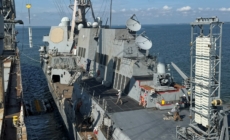-
With Epstein, Trump Betrays His Brand. His Supporters Notice. - 12 mins ago
-
Donald Trump Inviting Sex Offender into White House Raises Eyebrows - 28 mins ago
-
A French Beach Town’s Plea to Tourists: Keep Your Clothes On - 56 mins ago
-
Eerie Video Shows Alaska-Bound Royal Carribean Cruise As Tsunami Threat Looms - about 1 hour ago
-
US Navy Warship Rearms at Sea With One Eye on China War - 2 hours ago
-
Judge Extends Protections for Migrants From Nepal, Honduras and Nicaragua - 2 hours ago
-
Mark Carney Responds to Donald Trump Raising Canada Tariffs - 2 hours ago
-
El Salvador Changes Constitution, Ending Term Limits for Nayib Bukele - 2 hours ago
-
Donald Trump Suffers Major Legal Blow Over Migrant Protections - 3 hours ago
-
Netanyahu Is Choosing to Starve Gaza - 3 hours ago
Satellite Imagery Shows China Upgrading Aircraft Carrier Base
Satellite imagery captured earlier this month shows the continued expansion of a Chinese naval base that hosts one of the nation’s aircraft carriers near the contested South China Sea.
Newsweek has contacted the Chinese defense and foreign ministries for comment via email.
Why It Matters
The Chinese navy—the largest naval force in the world by hull count—serves as a key instrument of Beijing’s military power. In June, China deployed both of its aircraft carriers, CNS Liaoning and CNS Shandong, simultaneously in the wider western Pacific.
Besides the Liaoning and the Shandong, China’s third and most advanced aircraft carrier, CNS Fujian, is set to be commissioned. Reports indicate that China plans to build its first nuclear-powered aircraft carrier, further challenging the United States’ naval supremacy.

Li Gang/Xinhua via AP, File
China’s naval buildup helps assert its sweeping sovereignty claims in the South China Sea, which encompass most of the waters and overlap with those of neighboring countries—often resulting in standoffs and clashes, particularly with the Philippines, a key U.S. treaty ally.
What To Know
AllSource Analysis—a Colorado-based geospatial intelligence provider—shared satellite imagery taken on July 17 that shows what it described as “ongoing construction activity” at Yulin Naval Base, located on the East Asian power’s southern island province of Hainan.
The Shandong—China’s second operational aircraft carrier—can be seen docked at a pier in the image, while a nearby existing pier is being expanded. Meanwhile, at least seven piers on the other side of the base are under construction, according to AllSource Analysis.
Further away from the aircraft carrier and close to a dry dock built in recent years, two berthing areas are under construction, with one of them estimated to be more than 3,000 feet long.
According to the Center for Strategic and International Studies’ ChinaPower project, the Shandong is estimated to be 999 feet long, meaning the aforementioned berthing area can theoretically accommodate three aircraft carriers of the Shandong‘s size simultaneously.
Infrastructure improvements in recent years have enhanced the base’s logistic support capabilities, allowing it to sustain “high operational readiness,” AllSource Analysis said, adding that such advancements enable China to project naval power across disputed waters.
In addition to Yulin Naval Base, Yuchi Naval Base—located in Shandong province in northeastern China and home to the country’s first aircraft carrier the Liaoning—is also under expansion, with at least four new piers being built, according to satellite imagery.
What People Are Saying
AllSource Analysis wrote in its July 17 report: “Developments at the Yulin Naval Base show ongoing upgrades likely to support China’s expanding naval force. Located in the South China Sea, Yulin serves as a strategic base and hosts the Chinese Navy Aircraft Carrier Shandong along with other warships.”
Alex Luck, a naval analyst in Australia, previously told Newsweek: “The benefit of tracking infrastructure is that these efforts are generally easier to observe, including on commercial satellite imagery, compared to naval construction. The latter is still difficult to assess in some respects due to its more secretive nature. … The basing infrastructure allows you to judge future scale and force mix to a reasonable extent regardless of such restrictions.”
What Happens Next
It remains to be seen which existing Chinese naval base capable of hosting aircraft carriers will serve as the homeport for the Fujian.
Source link




















